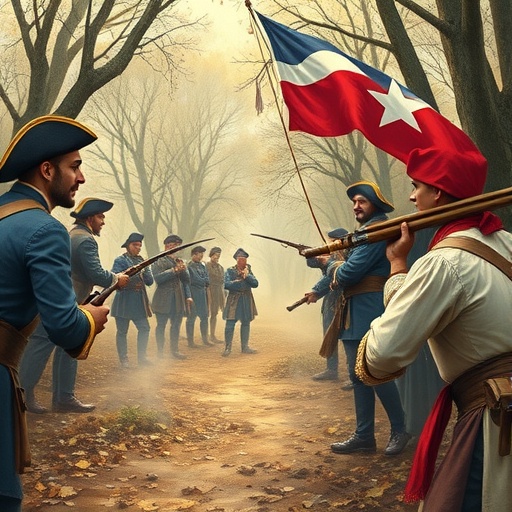In a significant advancement for the field of historical education, Nathan Sleeter, Research Assistant Professor in History and Art History at George Mason University’s Roy Rosenzweig Center for History and New Media (RRCHNM), has secured notable funding to develop innovative teaching guides focused on the Revolutionary War. This project, rooted deeply in primary historical documents, promises to offer educators unique resources to better illustrate the experiences and contributions of Black and Indigenous Americans during this pivotal period in history. By leveraging a rich array of source materials, Sleeter’s work aims to fundamentally transform the way this critical subject is taught in classrooms, grounding lesson plans in authentic evidence and promoting a nuanced understanding of historical narratives.
Sleeter’s funding, amounting to $25,000 from the American Historical Association through a subaward from the Library of Congress, underscores the growing recognition within academic and educational communities of the importance of diversified historical perspectives. The project commenced in June 2025 and is slated for completion by late May 2026, marking a year-long endeavor to produce these comprehensive teaching guides. The initiative is designed not only to provide educators with scripted content but also to immerse them and their students in active learning and critical historical thinking practices, thus fostering engagement and deeper analytical skills when encountering historical evidence.
Central to Sleeter’s approach is the utilization of primary source materials housed within the Library of Congress, one of the world’s most extensive and prestigious archives. This profound collection includes firsthand accounts, such as diaries belonging to Revolutionary War participants, pay stubs issued during the wartime period, contemporary prints, and newspaper articles, as well as a wide spectrum of official documents and various artifacts. Such primary sources are invaluable because they deliver an unfiltered glimpse into the past, allowing educators and students to directly interact with the voices and materials of those who lived through the era, rather than relying solely on secondary interpretations.
The focus on Black and Indigenous Americans during the Revolutionary War is particularly timely and vital. Historically marginalized in many narratives, these groups played indispensable roles that have often been overlooked or understated in traditional curricula. Sleeter’s guides will spotlight these communities’ varied experiences, challenges, and contributions, thereby offering a more holistic and inclusive historical account. By emphasizing such perspectives, the project contributes to broader historiographical efforts that seek to reframe dominant narratives and acknowledge the diversity of actors and events that shaped the founding of the United States.
In constructing these guides, Sleeter is committed to incorporating best practices drawn from pedagogical research in history education. Active learning strategies will be emphasized, encouraging learners to engage in dialogue, document analysis, and historical interpretation rather than passive reception of facts. Moreover, historical thinking—an essential skill that involves evaluating sources, recognizing bias, understanding context, and synthesizing complex information—will be at the core of the teaching methodology, fostering students’ critical engagement with history.
The development process is collaborative and iterative. Sleeter plans to work closely with professional historians and teacher education professors to refine the guides. Feedback loops will ensure that the content is both academically rigorous and practically effective in educational settings. This continual revision process is a hallmark of exceptional educational material development, ensuring that the resources remain relevant, accurate, and pedagogically sound.
Once finalized, the teaching guides will be made freely accessible through the website teachinghistory.org, a well-established platform dedicated to history education. By choosing an open-access model, the project guarantees widespread dissemination, allowing teachers across the United States and potentially beyond to benefit from this valuable resource. Accessibility and broad availability are critical factors in scaling educational impact, particularly for resources that address historically underserved narratives.
The collaboration between George Mason University’s RRCHNM and the Library of Congress exemplifies a productive partnership between academic institutions and federal repositories that seek to maximize the potential of archival materials for education. The Library of Congress’s role as funder and primary source provider ensures that the project is deeply embedded within authentic historical material culture, enhancing its credibility and educational value.
This endeavor aligns with contemporary trends in history education that prioritize source-based learning and the unpacking of complex historical truths. By moving away from rote memorization toward artifact-driven inquiry, the teaching guides will help to cultivate students’ abilities to think historically, analyze evidence, and appreciate the multifaceted nature of the Revolutionary War era.
Furthermore, the project’s timing is notable, given the current educational climate where issues of inclusivity, representation, and critical examination of history are increasingly foregrounded. Sleeter’s focus contributes to the ongoing discourse surrounding how the United States’ history is taught and understood, challenging educators and students alike to confront and integrate diverse historical experiences.
In summary, Nathan Sleeter’s funded initiative represents an important scholarly and educational intervention with the potential to reshape the teaching of the Revolutionary War. Through rigorous engagement with Library of Congress resources, adherence to modern pedagogical frameworks, and an emphasis on often overlooked communities, the project promises to enrich understanding and conversation around a foundational period of American history. As it progresses toward public release, it is poised to become an indispensable tool for educators striving to bring history to life in the classroom with accuracy, depth, and inclusiveness.
Subject of Research: Revolutionary War teaching guides focusing on the experiences of Black and Indigenous Americans during the Revolutionary War.
Article Title: (Not Provided)
News Publication Date: (Not Provided)
Web References: https://teachinghistory.org/
References: Funded by American Historical Association; primary sources from the Library of Congress.
Image Credits: (Not Provided)
Keywords: Education, Social sciences




